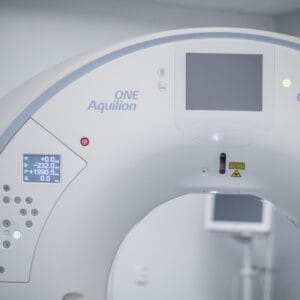Oncological Treatment of Breast Cancer

At Clinic Helena, an oncologist plans your individual breast cancer treatment in connection with your breast cancer surgery. Oncological treatment means cancer treatments that can include drug therapy, radiation therapy, and hormonal therapy. Drug therapies for cancer are often referred to as cytostatic therapy or chemotherapy. In the past, the term “cytotoxic” was also used, but it does not describe well the healing effect of modern cytostatic drugs.
Oncological treatment is used to ensure that the tumour is destroyed completely and that no cancer cells remain in the body after cancer surgery.
Planning for Further Ttreatment of Breast Cancer
After breast cancer surgery, a pathologist analyses all removed tissue sections and makes a final evaluation of the extent of the patient’s breast cancer. Based on the findings, an oncologist then plans the oncological aftercare. This treatment also known as adjuvant therapy includes cytostatic therapy, radiotherapy, and hormonal therapy as needed.
In certain cases, oncological care with chemotherapy is performed before surgery, for example in cases of inflammatory breast cancer (neo-adjuvant treatment).
When choosing the right oncological treatment, the oncologist considers:
- The type and size of the tumour
- The aggressiveness (gradus)
- Cell invasion in neighbouring tissue like small vessels, lymph ducts or nerves
- Immuno-histological receptor (estrogen-, progesterone-, HER2) status
- Cell proliferation activity (Ki67) define the oncological after care.
Cytostatic Therapy for Breast Cancer
The purpose of cytostatic therapy is to totally destroy or at least prevent the growth of cancer cells in the body. Cancer cells grow faster than healthy cells and these fast-growing cells are most susceptible to destruction. Some healthy cells are also lost during the treatment. Therefore, blood levels are monitored at regular intervals allowing the oncologist to adjust the dosage according to the patient’s individual response.
The treatment is begun one month after the breast cancer surgery. Our oncologists plan the postoperative chemotherapy individually for each patient, depending on the type, size, stage and grade of the breast cancer at the time of diagnosis.
In addition to chemotherapy, in Clinic Helena all patients who undergo breast-conserving surgery also receive radiotherapy. If necessary, radiotherapy will also be given after mastectomy surgery.
Chemotherapy Before Breast Cancer Surgery
In some cases, cytostatic therapy, or chemotherapy, is started before surgery to shrink the tumour. The decision to start treatment is made on an individual basis, for example to allow breast-sparing surgery in a broad local disease or to enhance the treatment of an inflammatory disease.
Today’s trend in the world is to give cytostatic treatments even before surgery. This was also done 30 years ago. In Finland, oncologists are critical of this. Only when there is scientific evidence that patients cope better will we move on to this practice.
In this case, the choice of drug is of great importance. At present, it seems that in the so-called triple-negative (missing all receptors) breast cancer, young people in particular could benefit from platinum-based cytostatic drugs before surgery. On the other hand, breast cancer, for example, with metaplastic features, is often very resistant to cytostatic drugs, in which case surgical treatment would be paramount.
Inflammatory Breast Cancer
When treating inflammatory breast cancer (the breast is red and swollen), three cycles of chemotherapy at three-week intervals are given already before the surgery (neoadjuvant therapy). The surgery is performed between cycles, and another 3-6 cycles of chemotherapy are given after the surgery according to the oncologist’s instructions.
Triple-negative Breast Cancer
Also, in the so-called “triple negative” type of breast cancer as well as in widespread cancer cases neoadjuvant therapy will be given.
Receptor-negative (estrogen, progesterone, and herseptin receptor-deficient) cancers as well as locally widespread cancers can also be treated partially or completely before surgery.
If the white blood cell count is too low after chemotherapy, the growth of white cells is stimulated by G-CSF treatment. This medication is usually given subcutaneously under the skin.
There are interesting studies which develop individual, targeted treatments for different stages of the disease. In the future, the adjuvant chemotherapy will be more and more individual depending on the nature of the tumour.
Quick Examinations and Treatment
If you have already been diagnosed with breast cancer or if, on the basis of your symptoms, you suspect it, you can access Helena Puonti’s consultation quickly and without a referral.
Why choose Clinic Helena:
- World-class expertise in breast cancer treatment, using the most modern methods.
- Helena Puonti’s unique Sensing Breast-method – available only at Clinic Helena.
- We devote ourselves to helping You recover completeley from your illness.
Side Effects of Chemotherapy
Most of the symptoms relating to the side effects of chemotherapy can be prevented or alleviated. All of them will disappear with time. Many normal, fast-regenerating healthy cells of the body are sensitive to cytostatic drugs. Millions of new cells are produced every day in, for example, the bone marrow, as well as in the scalp and in the mucous membranes of the mouth and the intestines.
Chemotherapy also destroys some of the healthy cells in the bone marrow, scalp and mucous membranes. Side effects related to this include low blood counts, hair loss, and digestive and intestinal problems.
Radiation Therapy for Breast Cancer
Radiation therapy is a commonly used method used to treat breast cancer. Radiation therapy is given approximately one month after cytostatic therapy.
All breasts operated with the breast-conserving method receive radiation therapy to prevent recurrence of the disease. After mastectomy surgery, radiotherapy is given if the tumour is large in size and/or there are clear metastases in the armpit.
Radiation is targeted to the breast area and in most cases also the armpit area. Sometimes also the lymph nodes in the supraclavicular area will be included in the radiation area.

How long does breast radiotherapy last?
The duration of radiotherapy for breast cancer is usually 3 weeks. For young patients or large breast tumours, an additional fourth week of radiation therapy is currently also recommended.
Side effects and recovery from radiotherapy
The side effects of radiotherapy for breast cancer are often minor and most commonly skin-related symptoms such as skin swelling, pain, and redness. Radiation therapy does not normally cause hair loss or nausea.
Skin irritation and other symptoms can be effectively prevented with instructions from our medical staff.
Dry skin “burns” more easily, so using moisturizers is beneficial. You should start using them after stitch removal at the latest. When applying moisturizers, the breast skin can be lightly massaged, allowing the skin’s blood circulation to recover better.
Occasionally, swelling may occur in the breast. To minimise the swelling, lymph therapy can be started, but only after the breast skin has recovered from radiotherapy.
During breast cancer radiotherapy, it is often advisable to take sick leave due to the regular nature and exact timing of treatments.
Recovery from the side effects of radiotherapy for breast cancer is individual, but usually, the side effects begin to subside rapidly within a few weeks of the end of the treatment.
Hormone Therapy for Breast Cancer
In most cases, after chemo- and radiotherapy, the doctor may still prescribe the patient hormone therapy known as anti-estrogen therapy. The goal of hormonal therapy is to lower the estrogen levels as much as possible as estrogen accelerates the division of cancer cells. Hormone therapy is used if estrogen and progesterone receptors are found in the tumour.
The duration of hormone therapy is 5-10 years, depending on the case.
Hormone therapy can also have side effects. Some experience early “menopausal symptoms,” heavy sweating, fatigue, and sleep disturbances. These should be discussed with your oncologist.
Sometimes it is possible to change the drug to a different medicine. In general, the side effects of hormonal drugs are minor.
Individual Treatment at Clinic Helena
It is possible to arrange oncological treatment at Clinic Helena as part of a comprehensive breast cancer treatment. If necessary, the patient can also continue the treatment with an oncologist in their home country. Clinic Helena specialises in breast-conserving surgery, oncological treatment, breast reconstructions, and breast cancer rehabilitation.






